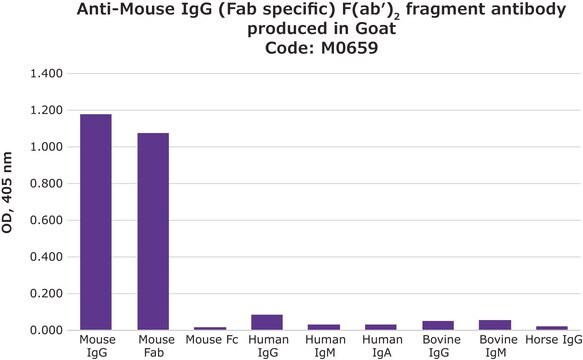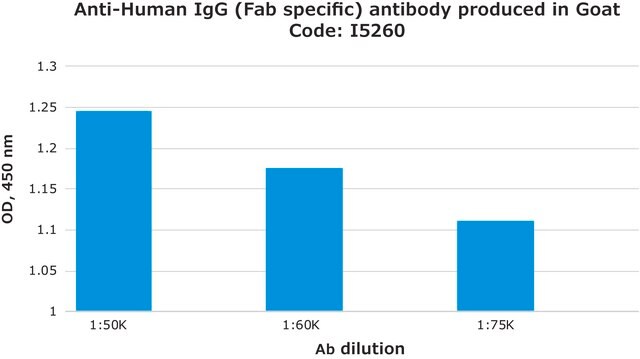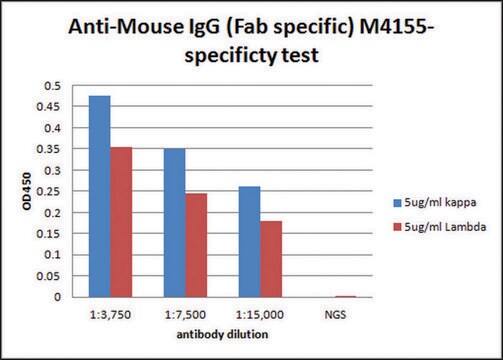M0284
Anti-Mouse IgG (Fc specific) F(ab′)2 fragment antibody produced in goat
2.0 mg/mL, affinity isolated antibody, buffered aqueous solution
Faça loginpara ver os preços organizacionais e de contrato
About This Item
Produtos recomendados
fonte biológica
goat
Nível de qualidade
conjugado
unconjugated
forma do anticorpo
affinity isolated antibody
tipo de produto de anticorpo
secondary antibodies
clone
polyclonal
Formulário
buffered aqueous solution
concentração
2.0 mg/mL
técnica(s)
indirect ELISA: suitable
Condições de expedição
dry ice
temperatura de armazenamento
−20°C
modificação pós-traducional do alvo
unmodified
Descrição geral
Immunoglobulin G (IgG) belongs to the immunoglobulin family and is a widely expressed serum antibody. An immunoglobulin has two heavy chains and two light chains connected by a disulfide bond.It mainly helps in immune defense. It is a glycoprotein.IgG is a major class of immunoglobulin.Mouse consists of five immunoglobulin classes- IgM, IgG, IgA, IgD and IgE. Mouse IgG is further divided into five classes- IgG1, IgG2a, IgG2b and IgG3.
Immunoglobulin G (IgG) is a glycoprotein antibody that regulates immune responses such as phagocytosis and is also involved in the development of autoimmune diseases . Mouse IgGs have four distinct isotypes, namely, IgG1, IgG2a, IgG2b, and IgG3. IgG1 regulates complement fixation in mice .
Imunogênio
Purified mouse IgG
Aplicação
Anti-Mouse IgG (Fc specific) F(ab′)2 fragment antibody produced in goat has been used in CD117/Sca-1 fluorescence-activated cell sorting (FACS) analysis and to detect bound factor H in factor H binding assay.
Ações bioquímicas/fisiológicas
Immunoglobulin G (IgG) participates in hypersensitivity type II and type III reactions. IgG helps in opsonization, complement fixation and antibody dependent cell mediated cytotoxicity.
Outras notas
Antibody adsorbed with bovine, equine and human serum proteins
forma física
Solution in 0.01 M phosphate buffered saline, pH 7.4, containing 0.05% sodium azide.
Nota de preparo
Adsorbed to reduce background with bovine, equine, or human samples.
Useful when trying to avoid background staining due to the presence of Fc receptors.
Useful when trying to avoid background staining due to the presence of Fc receptors.
Exoneração de responsabilidade
Unless otherwise stated in our catalog or other company documentation accompanying the product(s), our products are intended for research use only and are not to be used for any other purpose, which includes but is not limited to, unauthorized commercial uses, in vitro diagnostic uses, ex vivo or in vivo therapeutic uses or any type of consumption or application to humans or animals.
Não está encontrando o produto certo?
Experimente o nosso Ferramenta de seleção de produtos.
Código de classe de armazenamento
12 - Non Combustible Liquids
Classe de risco de água (WGK)
nwg
Ponto de fulgor (°F)
Not applicable
Ponto de fulgor (°C)
Not applicable
Escolha uma das versões mais recentes:
Já possui este produto?
Encontre a documentação dos produtos que você adquiriu recentemente na biblioteca de documentos.
The Laboratory Rat (1998)
Liliana Grajales et al.
Journal of molecular and cellular cardiology, 48(4), 735-745 (2010-01-12)
Bone marrow-derived mesenchymal stem cells (BM-MSCs) can be induced to differentiate into myogenic cells. Despite their potential, previous studies have not been successful in producing a high percentage of cardiac-like cells with a muscle phenotype. We hypothesized that cardiac lineage
Producing an Anti-β2 Integrin MAb By a Hybridoma Cell Line in a 2-Liter Stirred-Tank Bioreactor.
Kallel, H, and Fathallah, D, M.
Bioprocess International, 1, 54-59 (2003)
The Immunoglobulins: Structure and Function (1998)
Delayed enrichment of mesenchymal cells promotes cardiac lineage and calcium transient development
Grajales L, et al.
Journal of Molecular and Cellular Cardiology, 48(4), 735-745 (2010)
Nossa equipe de cientistas tem experiência em todas as áreas de pesquisa, incluindo Life Sciences, ciência de materiais, síntese química, cromatografia, química analítica e muitas outras.
Entre em contato com a assistência técnica








